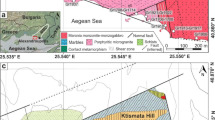Abstract
The 150 m thick late Miocene Graveyard Point sill (GPS) is situated at the Idaho-Oregon border near the southwestern edge of the western Snake River Plain. It records from bottom to top continuous fractional crystallization of a tholeiitic parent magma (lower chilled border, FeO/(FeO+MgO) = 0.59, Ni = 90 ppm) towards granophyres (late pods and dikes, FeO/(FeO+MgO) = 0.98, 78 wt% SiO2 3.5 wt% K2O, <4 ppm Ni) showing a typical trend of Fe and P enrichment. Fractionating minerals are olivine (Fo79-Fo2), augite (X Fe = 0.18−0.95), feldspars (An80Or1-An1Or62), Fe-Ti oxides (Ti-rich magnetite and ilmenite), apatite and in two samples super-calcic pigeonite (Wo18–28 Fs41–54). The granophyres may bear some quartz. Compositionally zoned minerals record a large interval of the fractionation process in every single sample, but this interval changes with stratigraphic height. In super-calcic pigeonite-bearing samples, olivine is scarce or lacking and because super-calcic pigeonite occurs as characteristic overgrowths on augite, its formation is interpreted to be related to the schematic reaction: augite + olivine (component in melt) + SiO2 (in melt) = pigeonite, that defines the cotectic between augite and pigeonite in olivine-saturated basaltic systems. Line measurements with the electron microprobe reveal that the transition from augite to super-calcic pigeonite is continuous. However, some crystals show an abrupt “reversal” towards augite after super-calcic pigeonite growth. Two processes compete with each other in the GPS: fractional crystallization of the bulk liquid (the bulk melt separates from solids and interstitial liquids in the solidification front) and fractional crystallization of interstitial melt in the solidification front itself. Interplay between those two processes is proposed to account for the observed variations in mineral chemistry and mineral textures.
Similar content being viewed by others
Author information
Authors and Affiliations
Additional information
Received: 25 November 1998 / Accepted: 14 June 1999
Rights and permissions
About this article
Cite this article
Markl, G., White, C. Complex zoning between super-calcic pigeonite and augite from the Graveyard Point sill, Oregon: a record of the interplay between bulk and interstitial liquid fractionation. Contrib Mineral Petrol 137, 170–183 (1999). https://doi.org/10.1007/s004100050589
Issue Date:
DOI: https://doi.org/10.1007/s004100050589




